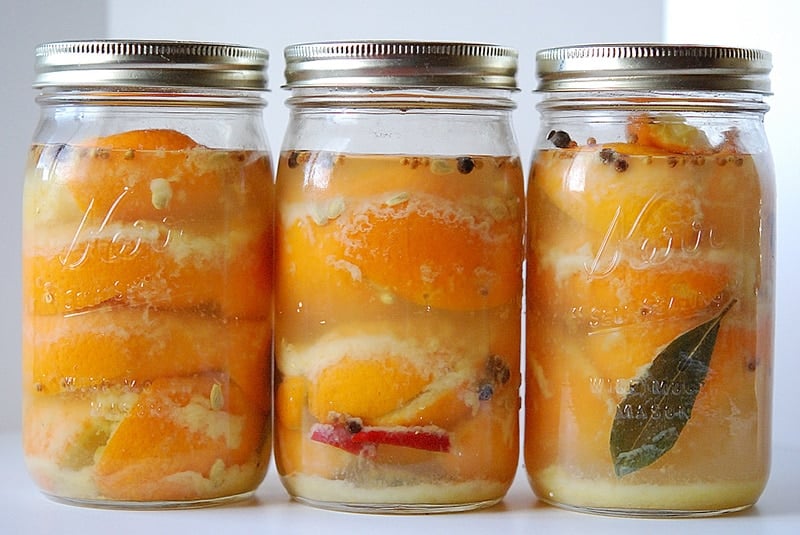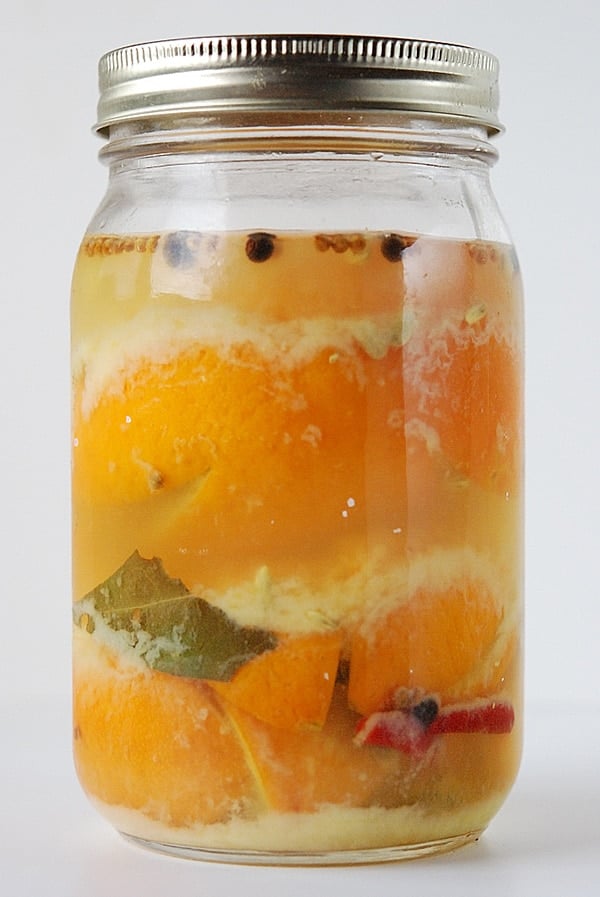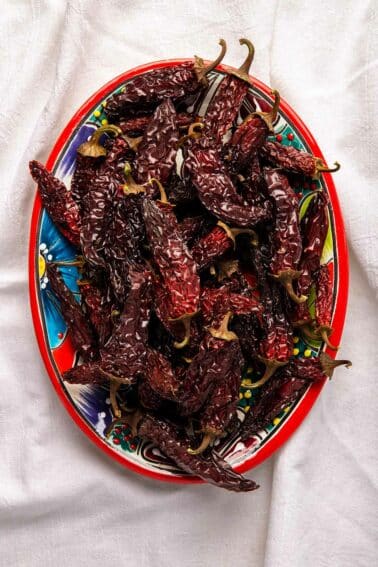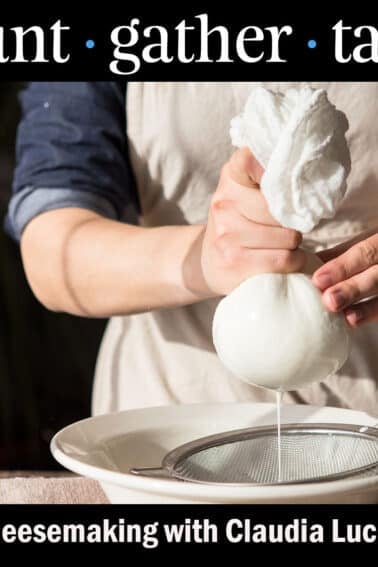As an Amazon Associate I earn from qualifying purchases.

I am here to free the preserved lemons from the grip of Morocco.
If you have heard of preserved lemons at all, you are probably conjuring images of exotic spices, tagines, cinnamon and lamb. This was definitely true for me until recently. When I looked for a method, all I found initially was version after version of Moroccan-style preserved lemons. Then I dug deeper.
I now know that there are scores of methods of pickling or preserving citrus. Wherever they are grown, they are preserved. Even in America. Anyone remember all those pickled limes appearing in Little Women? Those were Florida key limes shipped up north by the barrel.
The earliest reference in English I can find for a modern recipe for preserved lemons comes from an English cookbook, “A New System of Domestic Cooking” by Maria Eliza Rundell, written all the way back in 1808. Rundell quarters her lemons, salts them down and spices them with mustard seed, ginger, chile and garlic. (My colleague, cookbook author Colman Andrews, found a reference even earlier, in a 1769 cookbook!)
A lot of 19th century recipes involve horseradish, mustard seed, ginger and mace. Cloves made appearances, as does nutmeg and ginger. Vinegar is a commonplace. Methods vary wildly. “Mrs. Bradley’s Housekeeper’s Guide” (1860) would have you salt down the quartered lemons, then sun dry them for days until leathery. Then pack into jars with ginger and vinegar and wait a t least 6 months. “They are best after a year old,” she says.
And these are just the Western methods. In Sri Lanka, they boil lemons until they split, then stuff the split part with salt and submerge the fruits in vinegar. Six months later, they are minced with shallot and chiles and served as a sort of gremolata with rice or curry.
Russians do something similar. They simply submerge their lemons in brine and wait. After a few months, they slice them thin and serve as a side dish with wild game. Cambodians also preserve their lemons whole.
The Greeks began by preserving citrons, then added lemons to their repertoire in the 1st century; if you’re Greek, one of the few good things about the Persians was that they brought the lemon to Greece. Their method for preserved lemons is simple: Quarter the fruits, salt, and cover in lemon juice.
In India, they chop the lemons and make a sort of sweet-spicy relish out of them. Chinese make preserved lemons, too, as do East Africans — in fact, the great Ibn Battuta reports eating preserved lemons in Somalia as early as 1325. Maybe Battuta, a Moroccan, brought the recipe back with him?
But why make preserved lemons at all? What’s the point, when you can find fresh ones at the supermarket all year?
The obvious answer is that before supermarkets, lemons, like other fruit, were a seasonal specialty. For me, I can’t get lemons from my yard after April or before November. I must buy them. Or tap my stash of preserved lemons that sits quietly in my pantry.
Preserved lemons are to fresh ones what cured salami is to fresh meat. No they are not fresh, but they are just as good, if not better. It is a different taste and sensation. Funkier, more mellow.
Yet a preserved lemon is still a very powerful thing. Intensely salty and acidic, a little bit goes a long way. I only use the rind. Some use the inner portion of the lemon, but I find the rind to be good enough — it has all the oils and the color, and once you strip off the white pith there is no bitterness.
How do I use them? Well, for starters:
- in North African food; this is the obvious one
- With raw fish and meats, such as sushi, ceviche or Italian crudo
- Slivered in salads or salsa
- As a garnish to vanilla ice cream
- With fruit granita
- In a gremolata (lemon, raw garlic and parsley)
- With baked fish
General rule of thumb is that preserved lemons work well wherever fresh ones do — with fish, white meats such as chicken, pheasant and rabbit, and even with red meats in certain places: A preserved lemon gremolata on a simple seared venison medallion adds an unusual touch.
Now is the time to grab a slew of mason jars and put some lemons up. How many? Keeping in mind this is a specialty pickle, I’d start with two or three quarts of the standard-style pickles.
But you might also want to pickle some whole like the Russians, and the sweet-sour-spicy Indian lemon relish is always a hit. See which method best suits your taste, and go heavy on that one next year — or, if you have a tree like we do, you can do a late batch again in early spring.

Three Ways to Preserve Lemons
The best time to preserve lemons here in California is the dead of winter, but before any big freezes. December-January is best. It could be different where you live. If you are buying your lemons, season doesn’t really matter as lemons are available from somewhere all year long.
Different lemons will produce different results. Meyer lemons are sweeter, a little less acidic and more orange in color than the standard Eureka lemons. You also can preserve limes in exactly the same way.
If you are buying lemons from a supermarket, you will need to scrub them with a brush first; no soap. You want to remove any residue or wax from the rind. If you are using your own lemons or those from the farmer’s market, you still need to wash and dry them to remove dirt from the surface.
The basic ingredients for preserving lemons are: the fruit, water and salt. Everything beyond that is optional.
Keep in mind there are dozens of ways to pickle lemons, and I am providing only three methods here: A Russian one, an Indian one and a more universal method employed by both the North Africans and early Americans and English. I’ll start with the Russian method.
RUSSIAN PRESERVED LEMONS
This is the whole lemon method. Simply submerge the washed and dried lemons in a brine. The strength of the brine should be 1 tablespoon of pickling salt — it must be pickling salt, which is available at most supermarkets — per cup of water.
Wait at least three weeks and slice thinly to eat. The Russians eat this as an accompaniment to wild game.
MOROCCAN or AMERICAN PRESERVED LEMONS
This is the method most people use for preserving lemons. I’ve found references to it dating back to a British cookbook from 1808, although now most people associate it with Moroccan cooking.
Slice the washed and dried lemons lengthwise, almost in quarters. You want the lemon to still be in one piece, but almost cut through. If you are using Eurekas, which often have little nubs on the ends, cut them off before you almost-quarter the lemons.
Using Kosher, pickling or pure sea salt, stuff the lemon. Pack it in well, and use about a tablespoon per lemon. Mush the lemon into a clean Mason jar; use quart jars. Repeat until you have the jar mostly full. Toss a little more salt on top.
Now you have several decisions to make. You can jam in some spices — I suggest a cinnamon stick, some peppercorns, a couple cloves and a bay leaf. And you can choose to cover the lemons with vinegar or lemon juice, or not. Some people just keep mushing the lemons down until their own juice covers them. The early British and Americans covered the lemons with vinegar. I cover them with lemon juice.
Seal the jars in a hot water bath (water at a simmer) for 10 minutes. This is not totally necessary, but I do it to be safe.
Wait at least 3 weeks before eating. I’ve kept these lemons for two years in the fridge and they were fine. They will darken over time.
INDIAN METHOD
This is a fancy method I’ve adapted from Linda Ziedrich’s The Joy of Pickling. It’s also sweet-sour from sugar, and spicy from cumin and chile peppers.
First slice the lemons into eighths — again without cutting all the way through, like the Moroccan method.
Get together the following: 1 part fennel seeds, 1 part cumin seeds, 1 part black peppercorns and 1 part pickling salt. Think a teaspoon of each per 3 lemons. In a dry pan, toast the fennel and cumin seeds over medium heat until they are fragrant. Grind all the spices together and stuff into the lemons.
Jam the lemons into a quart jar and cover with extra lemon juice. Cover and let sit at room temperature for a week.
When the week is up, pour out all the juices into a non-reactive pan. Squeeze the lemons gently to release more liquid and put that in the pan. Bring the liquid to a simmer, adding sugar to taste. You want it sweet-sour.
Once the sugar has dissolved, add 1 to 4 small hot chiles; depends how hot you want it. Put the lemons back in the liquid and simmer gently for 10 minutes.
Using tongs, remove the lemons and put them back in the jar. Cover with the liquid and seal. Wait a month before eating.






Hello Hank,
I’ve been enjoying your blog for the past hour or so – thanks! And here’s a different version of pickled lemons that can be eaten the same day (but ferment deliciously):
Slice your lemons thinly put about half a teaspoon of mustard seeds, a few slices of green chili, a smashed piece of garlic, half a teaspoon of sea salt and half a teaspoon of sweet paprika at the bottom of a jar. layer the lemons and every couple of inches repeat salt-paprika-chili-garlic (omitting the mustard seeds). Every now and then tamp down the lemons to release the juice and continue until the jar is packed. finish off with sunflower seed oil. it’ll be ready in a few hours, but gets better after a few days. when you’ve eaten all the lemons, you can use the spicy, lemony-bitter oil left in the jar too.
thanks again for a great read and recipes
`Heela
Hank, when you are talking about slicing them and eating them, are you talking about eating the rind as well?
Jordan: I only eat the rind, actually.
I only preserve the rind. Remove it from the lemon with a potato peeler, cover with lemon juice and salt in a mason jar. Store in refrigerator. Most recipes only have you use the rind part anyway, so why bother taking up space with the rest. I use the rind just as I would use fresh rind. If using in a dessert, just rinse off salt. A quart or two will provide enough rind for the part of the year, I don’t have fresh.
Stacy: Good point. Yeah, I only use the rind, too.
Can you post some pictures of the “almost quartered” process? I think I’ve “almost” got it, but my brain is thinking of like 3 different ways to do it.
Limoncello: It’s in the images of the lemons, but basically slice a lemon lengthwise almost to one end, and then make another slice perpendicular to the first.
Going more classical, I just did a batch using Etrog citrons. They’re aging now. We’ll see how they turn out.
My top lemons have gone a little brown and don’t seem to be covered in the liquid are they still ok to use??
Kim: I’d toss them.
You mention that the earliest reference you can find in English to preserving lemons is in Mrs. Rundell’s book from 1808. In fact there’s one in “The Experienced English Housekeeper”by Elizabeth Raffald, published in 1769. In fact she goes on about how the combination of lemon pickle and “browning”(the ancestor of Kitchen Bouquet and suchlike)”answers for both beauty and taste” is sauces better than “cullis” (strong beef stock).
Colman: Wow, a) really great to hear from you — love your books! and b) Nice find, thanks!
My daughter and I went on an adventure around the world with salted lemons, starting with a case of small lemons. Not only did we do lots of internet research, we personally met women from around the world who make and use salted lemons in their favorite home cooking.
After reading the internet,talking to cousins who grew up in the south, old friends from Jordan, new friend from Israel, a beautiful Tibetan woman who lives in North India we met on the beach, good food is indeed the international language.
DD and I settled on a basic recipe which could be adapted and enjoyed by everyone. Lemons, salt, peppercorns. For the extra lemon juice I used my VitaMix and not a juice extractor. I juiced peel and lemon, discarding most of the pith. This completely maximizes the anti-oxidant properties and flavor.
1 case of small lemons gave us 2 cases of pint jars, 1/2 gallon crock and 1 quart crock of the most awesome, eye-popping, versatile treat ever. Lemon pickles go way beyond their traditional roots.
Thanks so much for your help. I’m really anxious to use these lemons.
Problem: How do you keep the lemons on the bottom? Mine float to the top and the liquid is cloudy. I used kosher sea salt, 1 tablespoon per lemon..some on bottom of jar and some on top. I did turn it to try to dissolve the salt. Should I have not done that?
You need to pack the lemons in the jar tighter. Cloudy is fine.
Patty: Nope. The salt protects them, so long as your temperatures are too high. So if your house gets above 75 degrees or so, keep them cooler. Fridge is OK, but a cool basement or pantry will work, too.
Do preserved lemons have to be refrigerated before opening?
I was doing some pickled lemons today, for the second time this year – the last time was for my mother in the Mediterranean, with lemons picked from a tree (which actually weren’t that juicy) – and I was just wondering what I’d left out apart from cloves. Or maybe that I’d made some immensely crass mistake. And that’s how I came across your site.
I’ve bookmarked your site and if this piece is indicative of what else is here then it’s going to be brilliant to know! I’m a pretty competent cook in general, but I’m always forgetting what I did last time or what was in that recipe I stole from some restaurant. And I’ve never managed to keep that promise that I will write down what I did that worked, so I’m endlessly making it up from scratch and trying to imagine what would have been in there.
What you have done here is fantastic and it’s so nice to get the breadth and the history as well. Believe me (or maybe please everyone else believe me) when I say that I recognise exactly the right things here; and it is so useful and instructive. None of this is difficult, and it’s lovely to have it presented plainly without any supposed magic attached to it because people have been doing this for centuries.
I have a particular love of lamb, and have recently moved back from France, and I’m just getting those staples we need settled in my cupboards; the things that you can’t do without if you are going to cook properly, like sharp knives, a potato peeler that works, onions by the bagful etc.. One of these, indispensable if you’re going to do a tagine, is pickled lemons. Even if you have got perfectly made merguez in there it is still never quite good enough without the lemons – they give it that authenticity. And that reminds me that I’m going to have to remember how to make harrissa so I can get a couple of breasts of lamb for 90 pence to make those sausages …
It looks brilliant. Thank you for your work.
Christian Thomas
Thank you so much for this recipes on preserving lemons. My Meyer lemon tree produced an abundance this season and then my aunt gave me bushels from her tree. Tried my hand at preserving after I found your article. The problem I faced is that only about halve of my jars sealed after the water bath. Will that create a problem or is that typical. Wondering if I am doing something wrong, I followed your instructions for the American/Morocan method of preserving. Help please since I still have many many more lemons! Thank you.
Started a batch of preserved lemons using a the Morocan/American method. They sat 5 days and the liquid started to turn reddish. Not a good sign. Amazes me as the lemons were covered with lemon juice with about 2 tablespoons of kosher salt. Peculiar. I’ll have to start a new batch and perhaps water bath process, as you say!
This is my first visit here. I found the site/information for preserving lemons so informative!
I am a lover of all things lemon, and in the past(before discovering acid errossion)
I would eat lemons as though they were oranges, sectioned -and savoured!
Tell me Hank, does the preservvation process affect the taste of the lemons ??? And how?
I’m guessing it does and hoping not much other than increasing the intense lemon taste!!!
Regards Hank!! Keep on blogging!
Great article Hank – thank you! I’m guessing that you recommend sealing the Russian lemons as well, correct?
Hi – thanks for informative article, it was a great read. I want to try pickling some of our home grown lemons but they’re so big I can’t fit them into the jar whole. Is is really essential that they aren’t sliced right through? I think I’ll need to quarter them!
Just a comment about “being safe”. For the Eureka lemon, there are no known pathogens that could survive the acidity to cause illness. Lemons and salt were often used to preserve OTHER foods. The step of a water bath is not needed.
I was looking for a recipe on preserving lemons and came across your article. What great information and great reading. My mom has a Meyer lemon tree and i can’t wait to get a couple of Mason jars and surprise her! Although she’s old school (92 and going strong!) and she knows all about canning and preserving. She has some funky looking vinegar fermenting right now. It looks funky but has great flavor. Thank you so much for your contribution and I enjoy reading all the comments.